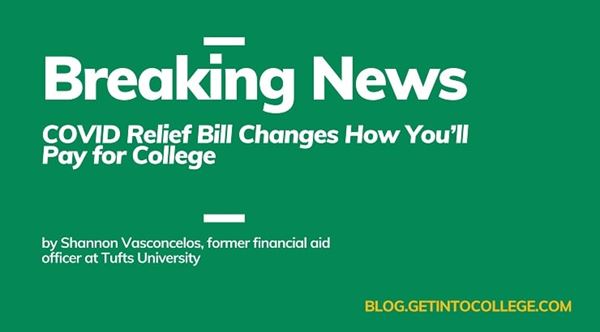COVID Relief Bill Changes How You’ll Pay for College
If you’ve been within shouting distance of a TV, computer, tablet, phone, or newspaper today, you’ve likely heard that Congress passed an omnibus spending bill last night, including a COVID relief package. What you may not have heard much about yet is a number of significant changes to federal financial aid programs included in the legislation. More details will be forthcoming, and the bill is still pending President Trump's signature, but, for now, here are the major provisions in the bill that may directly or indirectly affect how students and parents pay for college:
COLLEGE RELIEF
- $23 billion in emergency relief will be provided to institutions of higher education, some of which will be used to supplement student aid programs.
- $1.3 billion in capital financing loans made to Historically Black Colleges and Universities (HBCUs) will be forgiven.
- Beginning with the 2024/25*** academic year (the start date applicable to most of these FAFSA changes to follow), the Free Application for Federal Student Aid (FAFSA) will be reduced from 108 to 36 questions. This FAFSA simplification has long been a primary legislative goal of Senator Lamar Alexander (TN), due to retire at the end of the year.
- The term Expected Family Contribution (EFC) will be replaced with the term Student Aid Index (SAI). There are some modifications to the calculation of this number, but the change in terminology is largely a recognition that families rarely end up actually contributing their EFC to college (they may end up paying more or less, depending upon aid awarded by the college and spending decisions made by the family) and the figure is primarily used as an index to allocate financial aid funding.
- The SAI can be as low as -$1,500 (as opposed to a minimum $0 EFC), allowing states, colleges, and other awarding agencies to identify the neediest students and target aid programs accordingly.
- The untaxed income questions on the FAFSA will be reduced to only data elements available on a tax return, allowing all income data required on the FAFSA to be provided through the IRS Data Retrieval Tool (DRT) and not manually input by families. Likely most significantly for families, this change means that contributions to employer-sponsored retirement plans like 401ks will no longer be considered untaxed income in the federal financial aid calculations.
- Child support received will be considered an asset of the recipient, not untaxed income. Assets are assessed more gently than income in the financial aid formula and are completely excluded from the calculations for lower-income families (now defined as parents making less than $60,000 annually and filing a simple tax return).
- For divorced/separated/never married parents, the custodial parent will now be determined by which parent provided greater financial support, not by which parent the student lived with more.
- Small, family-owned businesses will no longer be excluded as an asset in the financial aid calculations.*
- The parents’ contribution to the SAI will not be split among the number of children they have enrolled in college the way their portion of the EFC currently is.*
- Drug convictions and Selective Service registration will no longer affect federal student aid eligibility.
- Colleges have been given new guidance on the use of professional judgement, including the prohibition of policies denying all financial aid appeals and the allowance for excluding income earned from work when the applicant can document the receipt of unemployment during times of national emergency.
- A number of changes were made to rules governing how colleges set their cost of attendance budget (a number which leads to maximum financial aid and student loan eligibility), including the requirement that colleges include allowances for three meals per day.
- New minimum and maximum Pell Grant eligibility standards have been created based solely on family size and Adjusted Gross Income (AGI). Families with income under 175% of the federal poverty line and single parents or single independent students with income less than 225% of the federal poverty line will qualify for the maximum Pell Grant. Previously based upon EFC, this simplification of Pell eligibility is meant to allow low-income families to know well in advance of college and aid applications that they will qualify for the maximum grant. It is hoped that this increased transparency will encourage increased college enrollment among low-income students.
- Pell Grant eligibility for incarcerated students has been restored.
- Pell Grant eligibility is restored for students affected by school closings or misdeeds.
- Employer loan repayment up to $5,250 annually has been made tax-free through 2025.
- The limit on Subsidized Direct Loan eligibility to 150% of a student’s academic program length has been repealed.
- The Department of Education will implement greater accountability and compliance measures over loan servicers and will allocate loans to servicers based upon performance.
- Borrowers will be granted greater flexibility in choosing a Federal Consolidation Loan servicer.
- The Department of Education is required to provide clearer communication and proactive outreach to borrowers about Public Service Loan Forgiveness (PSLF) eligibility criteria.
- The Tuition and Fees Deduction has been repealed.
- Beginning with the 2021 tax year, income limits for the Lifetime Learning Credit (LLC) have been increased to phase out between $80,000 and $90,000 of income for single tax filers and between $160,000 and $180,000 of income those filing a joint return. This increase brings the income limitations for the LLC, the tax break most beneficial for graduate students, part-time students, and fifth-year undergrads, in line with those of the American Opportunity Tax Credit (AOTC), the tax break available to full-time students in their first four years of undergraduate education (and their parents).






